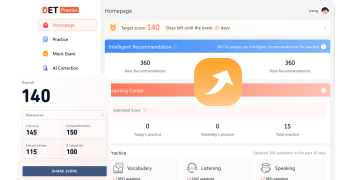듀오링고 영어 시험에서 '읽고, 그 다음 쓰기' 도전 과제를 정복하기
영어에 열정을 가진 여러분과 Duolingo 영어 시험 응시자들 환영합니다! 오늘은 DET의 ‘읽기, 그 다음 쓰기’ 섹션을 탐구할 것입니다. 이 부분은 여러분이 영어를 이해하고 효과적으로 쓰는 능력을 평가하는 중요한 부분입니다. 많은 사람들이 이 섹션이 시간 제약과 깊이 있는 답변 요구로 인해 벅차다고 느끼지만, 걱정하지 마세요! 이 게시물은 여러분이 자신감을 가지고 접근하고 이 섹션을 정복할 수 있도록 돕는 전략 가이드입니다.
‘읽기, 그 다음 쓰기’ 작업은 여러분이 5분 안에 응답을 작성해야 하는 프롬프트를 제공합니다. 도전적으로 들리죠? 하지만 올바른 접근 방식을 통해 이 도전을 영어 능력을 보여주는 기회로 바꿀 수 있습니다. 숙련된 영어 화자이든 언어 학습자이든 이 가이드는 성공을 보장하기 위한 실용적인 전략, 시간 관리 팁, 심지어 응답 템플릿을 제공할 것입니다. 그러니 함께 이 여정을 시작해 우리 글쓰기를 좋음에서 뛰어넘게 만들어 봅시다!
프롬프트를 이해하고 응답 구조화, 어휘 풍부화, 그리고 그 외 많은 통찰력 있는 팁을 지켜봐 주세요. 여러분의 연습을 올바른 방향으로 이끌어 줄 조정 가능한 템플릿도 함께 제공됩니다. ‘읽기, 그 다음 쓰기’ 섹션을 성공적으로 마칠 준비가 되셨나요? 시작해 봅시다!

1. 프롬프트 이해하기: 목표 지향적 응답의 핵심
‘읽기, 그 다음 쓰기’ 섹션에 들어가려면 한 가지 중요한 단계가 있습니다: 프롬프트를 이해하는 것입니다. 이 섹션은 단순한 언어 능력만이 아니라 분석 능력 또한 요구합니다. 올바른 방향으로 나아가기 위해 다음을 따라야 합니다:
첫째, 프롬프트를 해체하세요. 그것을 구성하는 기본 요소로 나누어 보세요. 주제는 무엇인가요? 특정 세부사항이나 비교가 요구되나요? 이러한 요소를 파악하는 것이 적절한 응답을 위해 필수적입니다.
둘째, 질문 유형을 파악하세요. 예를 들어 설명적인 응답을 요청하는지 아니면 주장을 내세우는 것인지 확인하세요. 여러분의 접근 방식은 이 구분에 달려 있습니다.
마지막으로 지시어에 주의를 기울이세요. ‘describe,’ ‘compare,’, 또는 ‘argue’와 같은 단어들은 시험 감독관이 원하는 것이 무엇인지 직접적으로 알려줍니다. 이것들을 무시하면 잘못된 길로 갈 수 있습니다.
예를 들어, 프롬프트: “새로운 것을 시도하기 두려웠던 마지막 순간에 대해 이야기해 보세요. 어떻게 시도할 용기를 찾았나요? 이 경험에서 인생에 도움이 되는 것은 무엇을 배웠나요?“
이를 해체하기 위해 세 가지 주요 요소를 식별하세요: 두려움의 개인적 경험, 그 두려움을 극복함, 그리고 배운 인생 교훈입니다. 이는 묘사적이면서도 반영적이며, 단순한 사건의 나열뿐만 아니라 개인적인 통찰력이 요구됩니다.
행동 단어를 주의 깊게 찾아보세요: ‘talk,’ ‘found the strength,’ 그리고 ‘learned.’ 이러한 단어들은 이야기 공유, 내면의 회복력에 대한 성찰, 그리고 더 넓은 인생 교훈을 제시하도록 안내합니다.
기억하세요, 이러한 프롬프트는 단순히 무슨 일이 있었는지를 묻는 것이 아닙니다. 이는 여러분에게 여정을 서술하고 그 영향에 대해 성찰하라고 초대하고 있습니다. 이를 완전히 이해함으로써, 여러분의 응답은 단순히 이야기를 나열하는 것이 아니라 개인적인 성장의 엿볼 수 있는 기회를 제공하게 됩니다. 이는 프롬프트가 요구하는 것과 완벽하게 일치합니다.
프롬프트는 여러분의 로드맵입니다; 이해하는 것은 첫 번째 단계일 뿐만 아니라, 평가자와 공감할 수 있는 매력적인 응답의 기초입니다. 그러니 잠시 시간을 내어 조심스럽게 읽고, 명확성이 여러분의 펜을 안내하도록 하세요!
2. 시간 관리의 달인 되기:
시간 관리의 달인이 되는 것은 응답을 작성하는 데 단 5분만 주어진 상황에서 매우 중요합니다. 여기에 전략적 분석이 있습니다:
빠르게 계획하기: 생각을 정리하고 개요를 만드는 데 1분을 사용하세요. 진행하고 싶은 아이디어와 논점을 적어보세요.
효율적으로 작성하기: 작성하는 데 3분을 할당하세요. 개요에 충실하고 문장을 간결하게 유지하세요. 명확성과 정확성을 추구하세요.
효과적으로 교정하기: 마지막 1분은 교정을 위해 확보하세요. 문법 오류를 확인하고, 프롬프트의 모든 부분에 답변했는지 확인하며, 어색한 phrasing을 다듬으세요.
시간을 현명하게 구조화함으로써 응답이 일관되고 깔끔하며 완성되도록 보장합니다. 시간 제한 내에 다듬어진 답변이 미완성이 된 걸작보다 낫다는 것을 기억하세요.
3. 응답 구조화: 간단하고 명확하게 유지하기
‘읽기, 그 다음 쓰기’ 섹션에서 단 5분밖에 없으므로 단순함이 핵심입니다. 다음은 명확하고 효과적인 응답을 구조화하는 방법입니다:
소개: 간단한 문장으로 프롬프트를 직접적으로 언급하십시오. 프롬프트가 개인 경험에 관한 것이라면, 장면을 설정하는 간결한 진술로 시작하세요.
본론: 개발할 주요 포인트 중 하나 또는 두 개를 선택하세요. 경험을 묘사한다면 가장 영향을 준 부분에 집중하세요. 주장을 한다면, 주된 이유를 명시하고 간략하게 뒷받침하세요.
결론: 경험을 반영하거나 주장을 요약하는 짧은 마무리로 끝내세요. 감동을 주되 간결하게 유지하세요.
이 단순한 구조는 여러분의 응답이 조직적이고 프롬프트에 집중할 수 있게 해줍니다. 제한된 시간을 최대한 활용할 수 있습니다.
“Talk about the last time you felt scared to do something new, but you did it anyway. How did you find the strength to try it? What did you learn from this experience that will help you in life?“라는 프롬프트를 가지고, 다음과 같이 간단한 구조를 시연해 보겠습니다:
소개: “Facing my long-standing fear of heights, I decided to try rock climbing, an activity that both terrified and intrigued me.”
본론: “Initially, the very thought of climbing filled me with dread. However, recognizing the importance of confronting my fears, I started with small, manageable climbs. I sought guidance from experienced climbers and gradually built my confidence through their support and my persistent practice. This journey was not just about climbing but about learning to trust in my abilities and the support of those around me. The moment I reached the top of my first significant climb, the overwhelming sense of achievement eclipsed any fear I had felt.”
결론: “This experience taught me that facing fears head-on, with preparation and support, can lead to profound personal growth.”
이 예시는 소개, 본론, 결론이라는 간단한 구조를 고수하여 5분 쓰기 작업에 적합한 일관되고 강력한 응답을 적절하게 넣고 있습니다.
4. 깊이보다 폭: 풍부한 응답 만들기
‘읽기, 그 다음 쓰기’ 섹션에서는 너무 많은 내용을 다루기보다 깊이에 집중하는 것이 중요합니다. 즉, 한두 가지 핵심 포인트를 선택하고 상세히 탐구하는 것을 의미합니다. 특정 사례와 개인적 통찰력을 사용하여 풍부하고 미묘한 응답을 제공합니다. 이 접근 방식은 비판적이고 반영적인 사고를 보여줄 뿐만 아니라, 여러분의 글쓰기가 매력적이고 의미 있을 수 있도록 보장합니다. 주제에 대한 깊은 이해를 보여주는 것을 목표로 하여, 응답이 평가자들에게 돋보이게 해야 합니다.
5. 언어 및 어휘: 정밀성과 다양성의 예술
다양하고 정밀한 어휘 사용은 <span class="noTranslate">‘읽기, 그 다음 쓰기</span> 섹션에서 매우 중요합니다. 여러분의 생각과 감정을 정확하게 전달하는 특정하고 표현력 있는 단어를 사용하도록 하세요. 이건 독자를 혼란스럽힐 수 있는 지나치게 복잡하거나 생소한 용어를 사용하는 것을 의미하지 않습니다. 대신, 언어 선택에서 명확성과 정밀성을 추구하세요. 동의어를 신중하게 사용하면 이해 가능성을 훼손하지 않으면서 텍스트에 풍부함을 더할 수 있습니다. 또한, 올바른 문법과 문장 구조는 여러분의 아이디어를 효과적으로 전달하고 평가자에게 좋은 인상을 남기는 데 필수적입니다.
보다 다양하고 정밀한 어휘로 응답을 다듬기 위해 다음과 같은 개선 사항을 고려할 수 있습니다:
소개: “Confronted by my perennial dread of altitudes, I embraced rock climbing, a venture that both daunted and captivated me.”
본론: “The notion of ascending vertical faces initially paralyzed me with fear. Acknowledging the necessity to confront my apprehensions, I embarked on modest ascents, under the tutelage of seasoned climbers. Their mentorship, coupled with my steadfast dedication, gradually fortified my confidence. This odyssey was not merely about climbing; it was an expedition in self-discovery and trust. Achieving the summit of my inaugural significant climb was a testament to surmounting fears through perseverance and communal support.”
결론: “This odyssey illuminated the essence of bravery, tenacity, and the significance of stepwise progression. It underscored that engaging directly with one’s fears, equipped with preparation and camaraderie, catalyzes profound self-evolution. These lessons serve as invaluable compasses for navigating future adversities with a fortified resolve.”
이 버전은 풍부한 어휘와 보다 서술적인 언어를 활용하여 경험을 생생하고 반사적으로 전하며, 정밀한 언어 선택이 서사의 깊이와 영향을 강화하는 방법을 보여줍니다.
6. 성공을 위한 템플릿: 다양한 질문 유형을 위한 구조적 접근 방식
‘읽기, 그 다음 쓰기’ 질문에 효과적으로 접근하려면, 설명적 및 주장적 프롬프트에 적합한 간단한 템플릿을 고려하세요:
설명적 프롬프트 템플릿:
- 소개: 상황이나 경험을 간단하게 소개합니다.
- 본론: 구체적인 세부정보를 포함하여 경험을 설명하고, 이야기의 생명을 불어넣기 위해 감각적 정보 및 감정을 중심으로 하세요.
- 결론: 경험에 대해 반영하며 개인적인 성장 또는 습득한 통찰을 강조합니다.
주장적 프롬프트 템플릿:
- 소개: 자신의 입장을 명확히 밝힙니다.
- 본론: 예시나 증거로 뒷받침되는 하나 또는 두 개의 강력한 주장을 제시합니다.
- 결론: 입장을 강화하며 주장이 어떻게 자신의 입장을 지지하는지 요약합니다.
이 템플릿은 명확하고 집중된 응답을 구성하는 청사진으로 작용합니다. 프롬프트에 따라 사용자 정의하는 것이 매력적인 답변을 제공하는 데 열쇠라는 것을 기억하세요.
7. 교정 관행: 세부사항에 대한 주의를 통해 품질 향상
교정은 여러분의 <span class="noTranslate">‘읽기, 그 다음 쓰기</span> 응답이 빛나도록 하는 마지막이자 결정적인 단계입니다. 이 단계는 단순히 오타를 찾는 것이 아니라, 명확성, 일관성 및 영향력을 향상시키기 위한 종합적인 검토입니다. 이 과정에 최소한 1분을 할당하고, 다음 단계를 따르세요:
1. 완성도 확인: 프롬프트를 다시 방문하여 응답이 모든 측면을 다루고 있는지 확인하세요. 질문의 일부를 놓치는 것은 점수에 상당한 영향을 미칠 수 있습니다.
2. 문법 및 구문 검토: 주어-동사 일치, 시제 사용 오류 및 잘못 배치된 수식어와 같은 일반적인 문법 오류를 찾아보세요. 문장이 원활하게 연결되고 구두점 사용이 가독성을 향상시키는지 확인하세요.
3. 어휘 및 명확성: 문맥에 적합하고 정확한 단어 선택을 확인하세요. 모호한 용어를 구체적인 용어로 교체하여 서사나 주장의 깊이를 더하세요.
4. 논리적 흐름: 아이디어의 구성을 평가하세요. 각 단락이 다음 단락으로 원활하게 전환되는지, 사고의 논리적 순서를 유지하는지 확인하세요.
5. 중복 제거: 반복적인 문장이나 불필요한 단어를 제거하세요. 간결함이 명확하고 강력한 글쓰기에 중요합니다.
6. 소리 내어 읽기: 텍스트를 들으면 조용히 읽을 때 놓쳤던 어색한 문구와 실수를 발견할 수 있습니다.
7. 철자 최종 점검: 자동 교정이 있어도 일부 실수는 알파벳 발음이나 여전히 유효한 단어 선택이 잘못되어 눈에 띄지 않을 수 있습니다.
이 교정 관행을 통합함으로써, 여러분의 응답은 문법적으로 올바를 뿐만 아니라 더 매력적이고 효과적이게 됩니다. 이 세밀한 다듬기 과정은 여러분의 글쓰기를 향상시켜 평가자에게 지속적인 인상을 남길 수 있습니다.
이 포괄적인 가이드 전체에서는 Duolingo 영어 테스트의 ‘읽기, 그 다음 쓰기’ 섹션을 효과적으로 탐색하기 위한 필수 전략과 실용적인 템플릿을 살펴보았습니다. 프롬프트를 정확하게 해독하고 소중한 5분을 현명하게 관리하며 응답을 구조화하여 명확성과 깊이를 부각하고, 텍스트를 풍부하게 하고 교정을 통해 초안을 다듬는 것까지—각 전략은 매력적인 답변을 작성하는 데 중요한 역할을 합니다. 이 섹션의 우수성은 지속적인 연습과 이러한 기술의 사려 깊은 적용에서 비롯됩니다. 이러한 전략을 귀하의 준비 루틴에 통합하고 점진적으로 기술을 다듬어 나가길 권장합니다. 각 연습 세션이 단순히 목표를 충족하는 것이 아니라 초과 달성을 위한 한 걸음이 되어 여러분을 성공으로 이끌 것입니다 <span class="noTranslate">DET</span>.
자세한 내용을 보려면 DET 준비 전략 을 클릭하세요.
DET에 대한 팁을 찾고 계신가요? 여기서 확인하세요: https://www.detpractice.com/category/pro-test-tips/
지금 무료로 우리의 DET 문제 은행에 가입하고 연습을 시작하세요.






